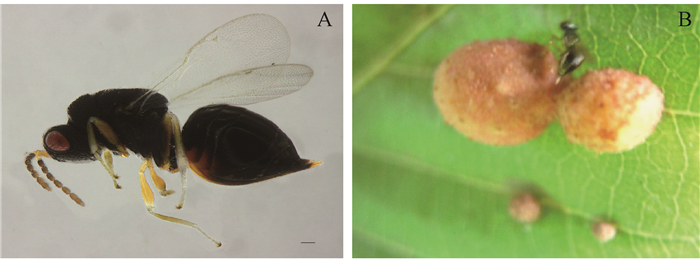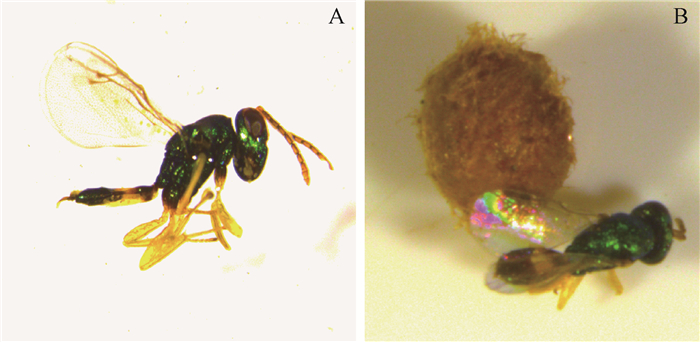文章信息
- 张元臣, 苏山玉, 刘苹, 张玉晓, 张坤朋, 王景顺.
- Zhang Yuanchen, Su Shanyu, Liu Ping, Zhang Yuxiao, Zhang Kunpeng, Wang Jingshun.
- 栎空腔瘿蜂虫瘿内天敌调查及其优势天敌生物学特性
- Survey of Natural Enemies in Gall of Trichagalma acutissimae (Hymenoptera: Cynipidae) and Biological of Its Predominant Parasitoids
- 林业科学, 2019, 55(2): 137-142.
- Scientia Silvae Sinicae, 2019, 55(2): 137-142.
- DOI: 10.11707/j.1001-7488.20190214
-
文章历史
- 收稿日期:2018-08-07
- 修回日期:2018-09-14
-
作者相关文章
2. 河南省安阳市林业局森防站 安阳 455000;
3. 河南省林州市林业局 林州 456550
2. Forestry Disease and Pest Control Station of Anyang, Henan Province Anyang 455000;
3. Forestry Bureau of Linzhou, Henan Province Linzhou 456550
栎空腔瘿蜂(Trichagalma acutissimae)(膜翅目Hymenoptera:瘿蜂科Cynipidae)为栓皮栎(Quercus variabilis)和麻栎(Q. acutissima)(壳斗科Fagaceae)的主要害虫,导致光合作用减弱,造成叶片早落,严重影响树势(王景顺等, 2013; 2014; 2015; Pujade-Villar et al., 2012)。栎空腔瘿蜂1年发生2代,以有性世代与无性世代交替进行,其中有性世代在栓皮栎雄花序上发生,而无性世代在栓皮栎叶片上发生(Wang et al., 2016)。由于瘿蜂幼虫藏匿于虫瘿中,化学药剂难以与其接触, 所以利用化学农药防治很难达到理想的效果(汪少妃等, 2015;Wang et al., 2013)。同时,大量使用杀虫剂也会杀伤天敌,影响天敌和物种的多样性,导致该虫更加难以控制。保护利用天敌资源,是瘿蜂生物防治的一项重要措施(骆有庆等, 1993; 吴步梅等, 2014; Ferracini et al., 2018; Stone et al., 2002; Mendel et al., 2017)。
瘿蜂虫瘿中的天敌资源十分丰富,在不同季节其群落的丰富度及优势种也不一样,群落成员之间的关系错综复杂(Abe et al., 2007),天敌生物学特性的调查对利用天敌及寄生效能的评价有非常重要的作用。目前,国内外已经对黄刺玫瘿蜂(Diplolepis sp.)(骆有庆, 1993)、板栗瘿蜂(Dryocosmus kuriphilus) (黄竞芳等, 1988)、加州瘿蜂(Andricus quercuscalifornicus)(Joseph et al., 2011)等瘿蜂的天敌种类和生物学特性进行了研究,目前还未见有对栎空腔瘿蜂优势天敌生物学特性的研究报道。本文调查了栎空腔瘿蜂优势天敌的生物学特性,旨在为利用天敌防治栎空腔瘿蜂提供参考。
1 材料与方法 1.1 栎空腔瘿蜂越冬期虫瘿内天敌种类和虫态的调查收集地位于河南省安阳市林州市姚村镇水河村,地理位置36°13′N, 113°47′E。2014年3月下旬,采集从栓皮栎树林脱落的枯虫瘿,一部分进行解剖,确定天敌的虫态,另一部分分别放入容积约为1 500 mL的塑料容器内。塑料容器下面铺2 cm左右的土,使土保持半湿润状态,虫瘿放在土层上,用纱网(100目)封住瓶口,定时观察记录出瘿天敌的种类和数量。
1.2 栎空腔瘿蜂有性世代生长期虫瘿内天敌种类和虫态的调查2013年4月中旬到5月中旬间,每隔3天收集一次栓皮栎花序上的无性世代虫瘿,放入200 mL广口瓶中,统计出瘿的天敌种类和数量,同时对虫瘿进行解剖,确定天敌的虫态。
1.3 栎空腔瘿蜂无性世代生长期虫瘿内天敌和虫态的调查2014年5月中旬至12月中旬栎空腔瘿蜂无性世代虫瘿期间,每隔10天左右收集一次虫瘿。一部分虫瘿放于200 mL广口瓶中常温培养,记录出瘿天敌的种类和数量,另一部分虫瘿进行解剖,分种类统计虫瘿内天敌的虫态。
1.4 栎空腔瘿蜂天敌成虫种群数量的调查选择3棵栓皮栎成龄树,从5月上旬开始,在每棵树上虫瘿较多的枝条附近,分别放置(25 cm×30 cm)粘虫板1块,粘虫板根据需要及时更换,每隔10天时间,逐块统计粘虫板上不同天敌成虫的数量,辅助确定各种天敌成虫的发生。以上收集的昆虫放入95%的酒精内,用于种类鉴定。
2 结果与分析 2.1 天敌种类在栎空腔瘿蜂有性世代虫瘿、生长期无性世代虫瘿(新瘿)和越冬期无性世代虫瘿(枯瘿)内共发现了3目9科的10种昆虫。主要为小蜂总科(Chalcidoidea)(7种),包括姬小蜂科(Eulophidae) 1种,金小蜂科(Pteromalidae) 1种,长尾小蜂科(Torymidae) 1种,广肩小蜂科(Eurytomidae) 2种,旋小蜂科(Eupelmidae) 1种,刻腹小蜂科(Ormyridae) 1种。另外,还有瘿蜂科(Cynipidae) 1种,象甲科(Curculionidae) 1种和小卷蛾科(Olethreutidae) 1种。其中,长尾小蜂(Torymus sp.)、广肩小蜂(Eurytoma sp.)和金小蜂(Pteromalus sp.)为优势天敌,对栎空腔瘿蜂种群数量起着重要调节作用。
2.2 长尾小蜂主要生物学特性通过对长尾小蜂各发育阶段调查发现(表 1和图 1 A),长尾小蜂1年发生2代,以幼虫在栎空腔瘿蜂无性世代虫瘿内越冬。野外越冬代幼虫4月下旬开始化蛹,5月中旬化蛹基本结束。5月上旬成虫开始出现,6月下旬基本结束。长尾小蜂越冬代成虫发生时期,恰逢栎空腔瘿蜂无性世代虫瘿形成初始期,成虫出现后寻找合适虫瘿产卵,6月上旬1代幼虫开始出现,6月下旬幼虫开始化蛹,7月下旬化蛹结束,7月上旬第1代成虫出现。羽化持续时间很长,9月份野外还可见少量成虫。幼虫外寄生于瘿蜂的幼虫和卵(图 1 B和C)。幼虫性活泼,与栎空腔瘿蜂幼虫或蛹同处一虫室内。10月下旬后开始越冬。
|
|

|
图 1 长尾小蜂雌蜂(A),长尾小蜂幼虫寄生栎空腔瘿蜂的幼虫(B)及蛹(C)的状态 Fig. 1 Female Torymus sp.(A), Larva (B) and pupae(C) of T. acutissimae parasitized by Torymus sp. larva |
广肩小蜂1年发生2代(表 2和图 2),以幼虫在虫瘿内越冬。越冬代幼虫4月下旬开始化蛹,5月下旬化蛹基本结束,蛹5月上旬羽化,6月上旬羽化结束。成虫羽化后产卵于无性世代虫瘿内,5月下旬1代幼虫开始孵化,6月上旬幼虫开始化蛹,7月中旬化蛹结束。第1代成虫6月下旬出现,可持续至8月下旬。幼虫外寄生于瘿蜂的幼虫。成虫出现后继续在虫瘿内产卵,孵化幼虫外寄生于瘿蜂幼虫体表,10月下旬幼虫开始越冬。
|
|

|
图 2 广肩小蜂雌蜂(A)及寄生栎空腔瘿瘿蜂虫瘿行为(B) Fig. 2 Eurytoma sp. (A) and its parasitic behavior on gall of T. acutissimae (B) |
该虫1年发生3代(表 3和图 3)。以幼虫在无性世代虫瘿内越冬,幼虫3月下旬化蛹,蛹4月上旬羽化出成虫,成虫产卵于栎空腔瘿蜂有性世代虫瘿内,第1代成虫5月上旬羽化,5月中下旬为第1代成虫产卵期,成虫将卵产于栎空腔瘿蜂无性世代虫瘿内,5月下旬至6月中旬为第1代幼虫发生期,幼虫6月下旬开始化蛹,至7月下旬结束。第2代成虫6月下旬出现,7月上中旬为发生盛期,至8月上旬发生基本结束。3代幼虫7月中旬出现,10月下旬幼虫进入越冬。
|
|

|
图 3 金小蜂(A)和寄生的有性栎空腔瘿蜂虫瘿(B) Fig. 3 Pteromalus sp. (A) and parasitic sexual gall of T. acutissimae(B) |
瘿蜂虫瘿中有多种天敌,研究较多的是栗瘿蜂,其虫瘿内目前记录的寄生性天敌有20多种(郭树嘉等, 1997; Abe et al., 2007; Ito et al., 2000; Kato et al., 2003; Murakami, 1997; Zhu et al., 2015)。本研究在栎空腔瘿蜂中仅发现了7种寄生性天敌,种类远少于栗瘿蜂。不同昆虫寄生性天敌区系明显不同(Toda et al., 2000),这可能是造成调查到的栎空腔瘿蜂天敌种类少的主要因素。另外,在自然条件下,调查地点和寄主植物也影响昆虫天敌得种类(Abe et al., 2007),这也可能造成栎空腔瘿蜂虫瘿中天敌种类不多的原因。
不同寄生蜂之间常出现以抢占相同寄主资源而产生的种间竞争(Harvey et al., 2013)。从生活史规律来看,栎空腔瘿蜂虫瘿中的长尾小蜂与广肩小蜂化蛹、羽化时间相近,而且均寄生栎空腔瘿蜂幼虫,它们之间很有可能也存在着种间竞争的现象。按照高斯生态位理论,资源利用相同的两个物种不能长期共存(Gause, 1934)。广肩小蜂和长尾小蜂也有可能寄生栎空腔瘿蜂其他虫态,从而产生生态位的分化,降低了种间的竞争,从而能够共存。这种情况是否存在,还需要进一步研究。
瘿蜂类害虫的虫瘿内有多种寄生蜂,这些寄生蜂导致瘿蜂有非常高的死亡率,能够对瘿蜂种群起到有效的调控(王景顺等, 2017; Schoenrogge et al., 1997; Stone et al., 2002)。从虫瘿中的长尾小蜂、广肩小蜂和金小蜂的生活史来看,在5月和6月下旬7月上旬2个时段是3种寄生蜂的羽化盛期,故在实施栎空腔瘿蜂的化学防治时,要注意避开这两个关键时期。
本文对在栎空腔瘿蜂虫瘿内完成生活史的主要寄生性天敌的生物学特性进行了初步观察,然而就整个虫瘿天敌群落的生活史而言,有许多问题亟待解决,如这些寄生性天敌是否为栎空腔瘿蜂的专性寄生蜂、是否存在其他寄主等还需要进一步观察。另外,栎空腔瘿蜂天敌群落中,一些未完全在虫瘿内完成整个生活史的种类生物学特性还不清楚,也需做进一步研究。
4 结论栎空腔瘿蜂虫瘿内有3种优势天敌,分别为长尾小蜂、广肩小蜂和金小蜂。长尾小蜂1年发生2代,越冬成虫5月上旬开始出现,产卵于无性虫瘿内,7月上旬第1代成虫出现;广肩小蜂1年发生2代,越冬成虫5月上旬开始羽化,成虫产卵于无性虫瘿内,6月下旬第1代成虫羽化;金小蜂1年发生3代,越冬成虫4月上旬羽化,成虫产卵于有性虫瘿内,第1代成虫5月上旬羽化,成虫羽化后将卵产于无性虫瘿内,第2代成虫6月下旬开始羽化。
长尾小蜂、广肩小蜂和金小蜂是防治栎空腔瘿蜂的重要天敌,栎空腔瘿蜂幼虫期是进行生物防治的最佳时期。每年的5月和6月下旬到7月上旬两个时段是3种寄生蜂的羽化盛期,在实施栎空腔瘿蜂的化学防治时,要注意避开寄生蜂的这2个时期,以保护天敌的多样性。
郭树嘉, 曲爱军, 孙伟. 1997. 栗瘿蜂寄生蜂的初步研究. 林业科学, 33(3): 242-246. (Guo S J, Qu A J, Sun W. 1997. A preliminary study on the parasitic wasp of Dryocosmus kuriphilus Y. Scientia Silvae Sinicae, 33(3): 242-246. DOI:10.3321/j.issn:1001-7488.1997.03.007 [in Chinese]) |
黄竞芳, 骆有庆, 廖定熹. 1988. 中国板栗瘿蜂天敌的研究. 林业科学, 24(2): 162-169. (Huang J F, Luo Y Q, Liao D X. 1988. Studies on the natural enemies of chestnut gall wasp in China. Scientia Silvae Sinicae, 24(2): 162-169. [in Chinese]) |
骆有庆. 1993. 黄刺玫瘿蜂及其寄生天敌的初步研究. 森林病虫通讯, (2): 5-8. (Luo Y Q. 1993. Preliminary study on gall wasp and its parasitic enemies. Forest Pest and Disease, (2): 5-8. [in Chinese]) |
骆有庆, 黄竞芳. 1993. 板栗瘿蜂寄生性天敌幼期形态研究. 林业科学, 29(1): 33-37. (Luo Y Q, Huang J F. 1993. A preliminary morphological study of immature stage of natural enemies of Dryocosmus kuriphilus Yasumatus. Scientia Silvae Sinicae, 29(1): 33-37. [in Chinese]) |
王景顺, 王相宏, Pujade-Villar J, 等. 2013. 栎空腔瘿蜂形态及生物学特性. 中国森林病虫, 32(1): 8-11, 96. (Wang J S, Wang X H, Pujade-Villar J, et al. 2013. Morphological character and bionomics of Trichagalma glabrosa. Forest Pest & Disease, 32(1): 8-11, 96. DOI:10.3969/j.issn.1671-0886.2013.01.003 [in Chinese]) |
王景顺, 王相宏, 武三安. 2014. 栎空腔瘿蜂自然种群生命表的组建与分析. 中国农学通报, 30(28): 29-33. (Wang J S, Wang X H, Wu S A. 2014. Construction and analysis of life table in natural population of oak gall wasp Trichagalma glabrosa. Chinese Agricultural Science Bulletin, 30(28): 29-33. [in Chinese]) |
王景顺, 王相宏, 张坤朋. 2015. 叶面喷雾防治栎空腔瘿蜂药效试验. 安阳工学院学报, 14(4): 81-82, 88. (Wang J S, Wang X H, Zhang K P. 2015. Efficacy test of foliar spraying against Trichagalma glabrosa. Journal of Anyang Institute of Technology, 14(4): 81-82, 88. DOI:10.3969/j.issn.1673-2928.2015.04.026 [in Chinese]) |
王景顺, 王相宏, 张元臣, 等. 2017. 栎空腔瘿蜂及其天敌长尾小蜂种群数量消长动态. 中国生物防治学报, 33(3): 326-330. (Wang J S, Wang X H, Zhang Y C, et al. 2017. Population dynamics of Trichagalma acutissimae (Hymenoptera:Cynipidae) and its natural enemy Torymus sp.(Hymenoptera:Torymidae). Chinese Journal of Biological Control, 33(3): 326-330. [in Chinese]) |
汪少妃, 唐真正, 袁毅, 等. 2015. 刺桐姬小蜂虫瘿发育及其结构. 林业科学, 51(1): 165-170. (Wang S F, Tang Z Z, Yuan Y, et al. 2015. Structure and development of insect-gall induced by Quadrastichus erythrinae. Scientia Silvae Sinicae, 51(1): 165-170. [in Chinese]) |
吴步梅, 王有琪, 张文利, 等. 2014. 玫瑰瘿长尾小蜂调查研究初报. 植物保护, 40(5): 148-151. (Wu B M, Wang Y Q, Zhang W L, et al. 2014. Preliminary report of investigation on Torymus bedeguaris. Plant Protection, 40(5): 148-151. DOI:10.3969/j.issn.0529-1542.2014.05.028 [in Chinese]) |
Abe Y, Melika G, Stone G N. 2007. The diversity and phylogeography of cynipid gall wasps (Hymenoptera: Cynipidae) of the oriental and eastern Palearctic regions, and their associated communities. Oriental Insects, 41(1): 169-212. DOI:10.1080/00305316.2007.10417504 |
Ferracini C, Ferrari E, Pontini M, et al. 2018. Effectiveness of Torymus sinensis: a successful long-term control of the Asian chestnut gall wasp in Italy. Journal of Pest Science. DOI:10.1007/s10340-018-0989-6 |
Gause G F. 1934. Experimental analysis of Vito Volterra's mathematical theory of the struggle for existence. Science, 79(2036): 16-17. |
Harvey J A, Erik H P, Toshiharu T. 2013. Intrinsic inter-and intraspecific competition in parasitoid wasps. Annual Review of Entomology, 58: 333-351. DOI:10.1146/annurev-ento-120811-153622 |
Ito M, Hijii N. 2000. Life history traits in the parasitoid complex associated with cynipid galls on three species of Fagaceae. Entomological Science, 3(3): 471-479. |
Joseph M B, Gentles M, Pearse I S. 2011. The parasitoid community of Andricus quercuscalifornicus and its association with gall size, phenology, and location. Biodiversity and Conservation, 20(1): 203-216. DOI:10.1007/s10531-010-9956-0 |
Kato K, Hijii N. 1993. Optimal clutch size of the chestnut gall wasp, Dryocosmus kurriphilus Yasumatsu (Hymenoptera; Cynipidae). Research in Population Ecology, 35: 1-14. DOI:10.1007/BF02515640 |
Mendel Z, Protasov A, La Salle J L, et al. 2017. Classical biological control of two Eucalyptus gall wasps: main outcome and conclusions. Biological Control, 105: 66-78. DOI:10.1016/j.biocontrol.2016.11.010 |
Murakami Y. 1997. Natural enemies of the chestnut gall wasp. Fukuoka, Japan: Kyushu University Press, 308.
|
Pujade-Villar J, Wang J S. 2012. A new species of the genus Trichagalma Mayr from China (Hym.: Cynipidae). Orsis: organismes i sistemes, 26: 91-101. |
Schoenrogge K, Crawley M, Walker P. 1999. Complex life cycles in Andricus kollari (Hymenoptera, Cynipidae) and their impact on associated parasitoid and inquiline species. Oikos, 84(2): 293. DOI:10.2307/3546724 |
Stone G N, Schonrogge K, Atkinson R J, et al. 2002. The population biology of oak gall wasps (Hymenoptera: Cynipidae). Annual Review of Entomology, 47: 633-668. DOI:10.1146/annurev.ento.47.091201.145247 |
Toda S, Miyazaki M, Osakabe M, et al. 2000. Occurrence and hybridization of two parasitoid wasps, Torymus sinensis Kamijo and T. beneficus Yasumatsu et Kamijo (Hymenoptera:Torymidae) in the Oki islands. Applied Entomology and Zoology, 35(1): 151-154. DOI:10.1303/aez.2000.151 |
Wang J S, Cui J X, Pujade-Villar J, et al. 2016. Description of the sexual generation of Trichagalma acutissimae (hymenoptera: cynipidae) and notes on its heterogonic life cycle. Journal of Asia-Pacific Entomology, 19(2): 405-413. DOI:10.1016/j.aspen.2016.04.008 |
Zhu D H, Liu Z, Lu P F, et al. 2015. New gall wasp species attacking chestnut trees: Dryocosmus zhuilin. sp. (Hymenoptera: Cynipidae) on Castanea henryi from southeastern China. Journal of Insect Science, 5(1): 156. |
 2019, Vol. 55
2019, Vol. 55

